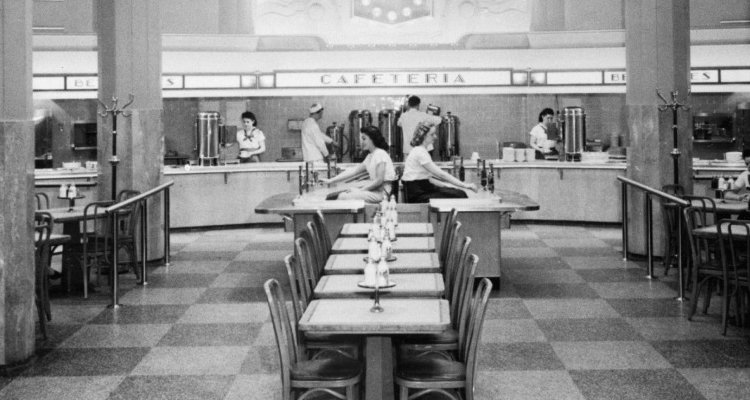A thematically robust and surprisingly introspective look at one of America’s most cherished (and oft-forgotten) institutions, “The Automat” is much like the products of its eponymous subject: easily accessible, thoughtfully produced, and quickly consumed. According to director Lisa Hurwitz, a one-time pillar of American commerce and the foremost symbol of early-twentieth-century urbanization, the automat was more than just an eatery: it was a harbinger of social, racial, gender, and economic sea changes. And while Hurwitz’s documentary stops just short of some interesting connections on the macro level, it manages to condense a great deal of fascinating history into a manageable morsel.
READ MORE: Telluride 2021 Preview: 10 Must-See Films To Watch
Relying on a rotating bench of talking-head interviews that span the gamut of customer, employee, historian, and simple admirer, the documentary explores the history of the automat in the United States, focusing on the most successful purveyor: Horn and Hardart. It was Joseph Horn and Frank Hardart that adopted the rough European automat model and refined it into a low-cost yet high-style dining experience via nickel-operated serving windows. Starting first in Philadelphia at the beginning of the 20th century, Horn and Hardart eventually expanded to New York City in 1912, meeting a growing demand for the throngs of workers and immigrants making their way into the east coast’s urban centers.
A combination of cheap but well-made food served instantaneously proved a runaway success, and over the years, the automat became an emblem of not just big city living but also a “part of the Americanization process.” By the 1950s, automats were serving 800,000 people a day, a volume that led to a fixed place in the collective memory of millions who viewed the eatery as a symbol of equality at a time when women, the poor, immigrants, and people of color had few non-household eating options available to them. Post-World War II inflation, demographic shifts, economic changes, and uneven management combined to spell the doom of the automat in the second half of the 20th century, however, and the doc takes the time to unpack all of this as well.
READ MORE: Fall 2021 Movie Preview: 60+ Must-See Films
Hurwitz keeps “The Automat” light on its feet throughout its brisk 79 minutes, never planting its flag on any particular narrative inroad. Whether it’s Mel Brooks relaying fond memories of Horn and Hardart from a familial perspective (the eatery factors into some of his earliest/fondest memories), Colin Powell talking about the automat’s color blindness, historian Alec Shuldiner contextualizing the restaurant model within the economic story of the century, or Howard Schultz explaining its inspiration on the founding of Starbucks, all of it feels like essential pieces to a larger story. This revolving cast of experts in their own specific fields gives what feels like a complete picture of the automat’s relatively brief history. Also, it includes long-time Horn and Hardart employees to provide some much-needed perspective about the operations side and how logistics and practical business needs factored into the broader story.
Although “The Automat” reveals its loving bias for the restaurant model early on, the documentary doesn’t move on a single track towards a foregone conclusion. Hurwitz’s piece isn’t a hagiography, leaving plenty of room for critiques on corporate short-sidedness and a social shift that saw people’s perception of the eatery shift with a rise in homelessness and poverty. A byproduct of a very specific time and place that landed at the nexus of several social, racial, and economic convergence points, the Horn and Hardart automat probably never had a chance after a certain point.
READ MORE: Telluride 2021 Lineup Includes ‘King Richard,’ ‘C’mon C’mon,’ ‘Louis Wain’ & More
Sadly, “The Automat” does not explore how other seemingly unconquerable brands fell victim to this multilayered national shift. In some of the stock photos presented in the doc, one can catch a glimpse of Gimble’s in the background, prompting one to wonder if the decline in automats coincided with the evaporation of business for other companies and what that might mean for 21st-century consumers looking at their own disappearing commercial landscape.
Do the lessons of Horn and Hardart apply to Woolworths, Sears, Toys R Us, or Blockbuster? It seems like a pertinent question to ask at a time when a global pandemic is shifting business models, minimum wage expectations, and even urbanization swings. Hurwitz stops short of these discussions, though, and while it might have been nice to explore these questions, it doesn’t act as a tripwire for the larger discussion. Indeed, “The Automat” is a fascinating, spritely expedition back in time, using a mostly forgotten yet remarkably influential restaurant model as its compass. A diverse group of “experts” leads the audience through a somewhat complex history that spans the better part of a century and leaves a viewer in much the same place as an automat customer: pleased at the product and its efficiency, with only passing questions about the bigger picture. [B+]
Follow along with our full coverage from the 2021 Telluride Film Festival here.

